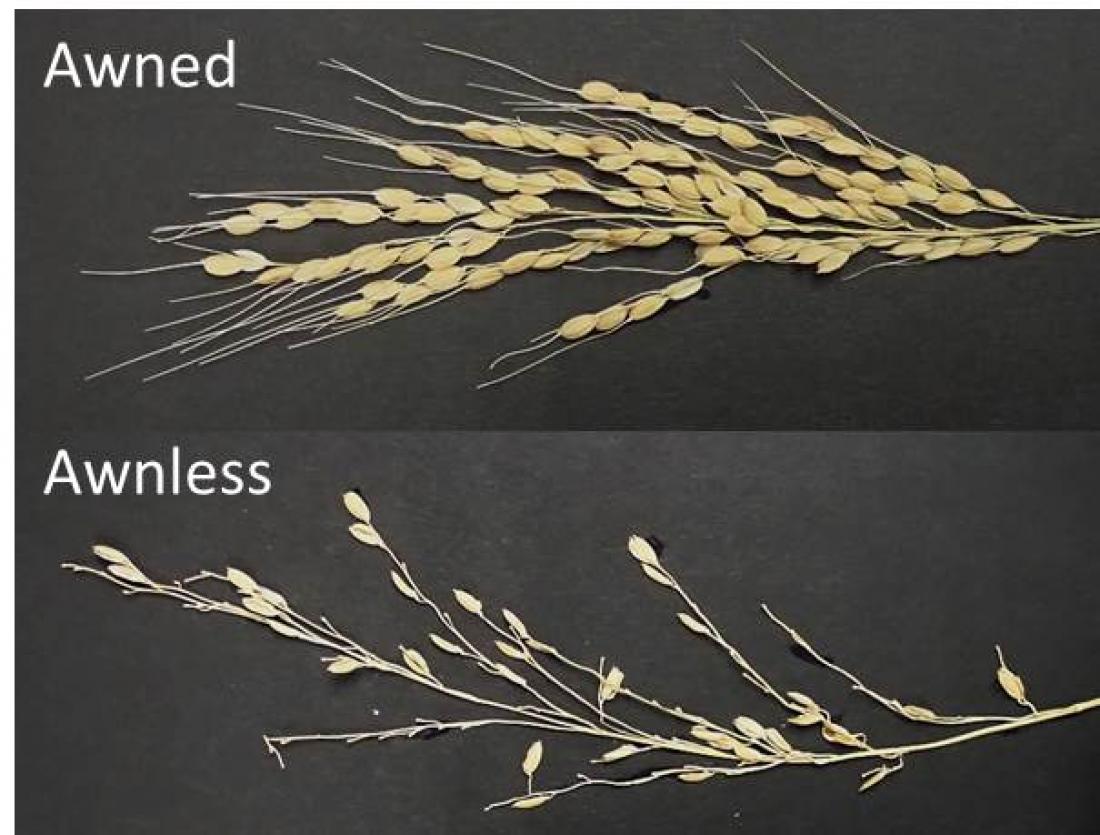Upper: Awned line (GLSL25), Lower: Awnless cultivar (Koshihikari) The cultivated rice which is awnless is easily damaged from sparrows or other animals’ predation. Awn works as barrier from seed predation under natural condition.
Nagoya, Japan – During cultivation of wild cereals such as rice for human agricultural use, a number of domestication-related traits have been selected for over time. These include an upright growth habit, the ability of the plant to keep its seed when ripe rather than dispersing it, and a lack of awns, which are bristles that grow from grass ears. Both Asian and African cultivated rice species share these traits despite their geographical isolation from each other. This suggests the traits’ usefulness in promoting agriculture. Indeed, awnlessness aids planting, harvesting, and storage of seeds. It was recently shown that awn development has been lost through human selection on sets of genes that differ between Asian and African rice. However, the mechanism underlying this process was unclear. An international research team has now identified a signal peptide expressed at the rice spikelet (flower) that is required for awn elongation of rice. Loss of this peptide’s function following genetic mutations is responsible for the awnlessness of cultivated Asian rice. The study was recently reported in PNAS.
The researchers used a genetic mapping technique to identify a region on rice chromosome 8 that appeared responsible for awn elongation in a breeding cross between awnless African and Asian rice parents. Methodical analysis of the region identified the RAE2 gene, which encodes a protein related to plant-specific peptides known to control plant development. The RAE2 peptide was shown to be functional in cultivated African rice but dysfunctional in cultivated Asian rice.
A comparison of amino acid sequences between RAE2 and related peptides from other plants, including awned grasses, revealed six cysteine residues that allow the peptide to form a particular structure. However, the peptide present in awnless Asian rice lacked two cysteine residues. “We compared the DNA sequence of RAE2 in different rice populations, and found a GC-rich region prone to genetic variation that encodes proteins with variable cysteine residues and, consequently, different lengths,” first author Kanako Bessho-Uehara says. “This variation disrupts the protein function and leads to awnlessness in Asian rice, but not African rice.” Awnlessness in latter involves another gene, RAE3.
The processing enzyme SLP1 cleaves the immature RAE2 peptide in the rice spikelet to promote awn elongation. “We speculate that RAE2 binds a receptor to mediate awn elongation, and that it may also induce development of vascular bundles,” corresponding author Motoyuki Ashikari says. “Our findings show that the awn can be used to view the role of human selection in early agriculture and cereal domestication.”



